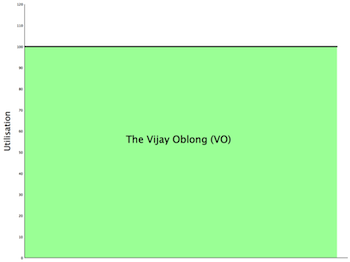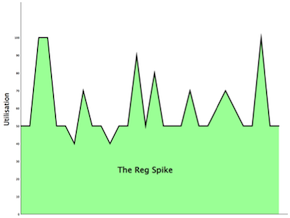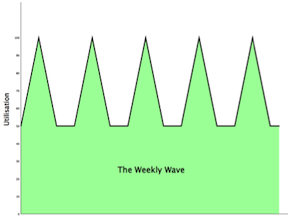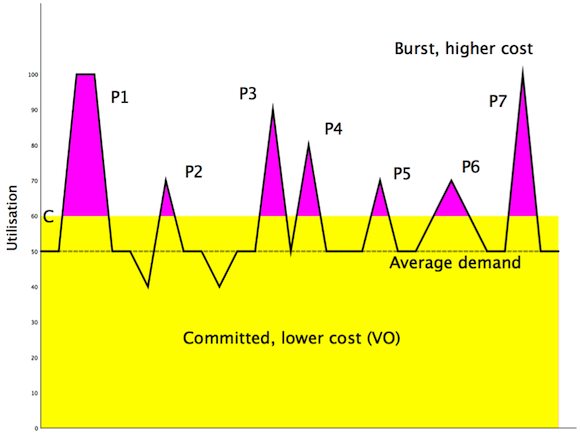This article is more than 1 year old
Bangs for bucks: Our lightning tour of cloudonomics
How to measure a piece of string
1. Hybrid is usually optimal
Let’s start with a model of demand that we will call, in deference to Gill, the Vijay Oblong: a data centre full of servers, fully utilised 100 per cent of the time, in a predictable way. Whether it is inside your data centre or at your hosting provider, this is rarely a cloud candidate, as Gill’s spreadsheet has shown.

The Vijay Oblong. Sometimes your working day seems like this
But this is rarely our experience. Most server demand follows one of two patterns:


Reg Spike and Weekly Wave: unknown unknowns and known unknowns
The Reg Spike is a steady basic utilisation, followed by irregular and unpredictable peaks. This is the load on our web site. Our peakiness is about two-to-one. We just don’t know when it will be.
The Weekly Wave is a predictable variation. You know when the load is heaviest.
For both of these, even if your own data centre costs (say) two-thirds as much to run as renting the same on-demand capacity from a cloud provider, you are better off with the cloud provider because the cloud provider charges for the shaded area only, whereas you would need to build internal capacity (a Vijay Oblong) which can handle peaks. This much is obvious.
In the case of the Weekly Wave, you can also get a better deal by reserving demand, because you know when you will need it.
Assuming that Gill’s rule of thumb holds, and 100 per cent utilisation is cheaper than on-demand cloud when you own (or at least colocate) your own capacity, then hybrid clouds will still always be cheaper on a day-to-day basis than either alternative, even if cloud service costs several times the price of your data centre service for the same job.
Smooth blend
The total cost is determined by how long demand stays at peak levels, not the unit cost of bursting to the cloud.
Note that we ignore setup cost, migration cost and so on; this assumes that you have migrated already.
If you are mixing hosting and cloud, and can move dynamically between them, it is even better than that because you set the optimum level at which you commit to capacity at your hoster. In this diagram, it is the yellow shaded region.

Don’t worry about the yellow bit.
If the per-unit cost of your variable cloud capacity is more expensive than your basic hosting, then your optimum hosting commitment is somewhere between your average and your peak, but it will always be strictly above the average.
If it is same price or cheaper, why commit to hybrid? For this diagram, total cost is:
(P1 + P2 + P3 + …) x (cloud unit cost) + VO x (hosting unit cost)
which you can minimise by adjusting the size of the Vijay Oblong and calculating cost using the data from your business.
In this way comparative cost between data centre, hosting and cloud does not tell us much. It is total cost, which you optimise by applying it to your demand pattern.
Apply migration costs (and any other capital expenditure impact) to this, and you have a much better idea of the economics of cloud.
2. Demand aggregation is triply efficient
The experience of virtualisation to maximise utilisation also offers insight for cloud economics. The trick is that the peak of the sum of demand will always be less than the sum of the peak in demand.
That is, if server one is at 80 per cent on some days, and server two is at 70 per cent on some days, then when they are combined you might get 150 per cent once or twice, but never more. And if you combine enough servers, you get much less peakiness.
It is never this neat, but the ability to consolidate workloads internally affects your choice of where to put them externally when considering cloud economics.
If two workloads cannot be consolidated, then their individual demand patterns may follow a Reg Spike or a Weekly Wave pattern, and each cloud decision has to be made independently.

Data centre efficiencies
This might be the case if the data cannot be moved out of the country, or if it is simply too expensive to create the infrastructure to consolidate. It doesn’t stop you from optimising the individual loads using hybrid cloud or hosting where it is effective.
If your data centre is dynamic enough to consolidate your workloads, and so you can use few, larger cloud providers, you can take advantage of three efficiencies:
- Your peak demand is never more than the sum of the individual peaks, even if the peaks coincide (for example, a global product launch), and spikes will be more predictable.
- Your Vijay Oblong is larger, and so a greater proportion of your demand can either be hosted, use efficient virtualised fixed infrastructure, or can use reserved demand in the cloud.
- You can consolidate your cloud requirement with the lowest-cost cloud provider that satisfies your requirement, which will always be cheaper than using a number of local providers (simply consolidate to the cheapest one).
3. Pay per use will eventually become the norm
How will the dynamics of cloud pricing alter your decisions? This underpins the whole analysis, because cloud pricing three years from now affects your infrastructure purchasing decision today.
This fascinating paper from the warm brain of Joe Weinman implies that pay-per-use pricing will supplant fixed-price hosting for all but a very few users. This implies that, as long as cloud develops equivalent services to hosting (or, with caveats, your internal data centre), pay-per-use will be the most economically efficient choice.
Exit this way
The logic is as follows. Imagine you have two choices: you rent a fixed amount of capacity, or you pay to use what you need. The fixed hoster has heavy users and light users. The lightest users are effectively buying capacity they don’t need, and so subsidising the heavy users.
They realise this and begin to defect to a pay-per-use model when it is cheaper. Maybe they read an article on The Register, for example, and are inspired to run the numbers.
As the light users who subsidised the service leave, the hoster has to raise prices for its remaining customers. This makes the service uneconomic for even more users, who defect to a pay-per-use cloud service.
This process continues until the only remaining hosting customers are those for whom it is still uneconomic to move, which will naturally be very large users, or those with regulatory barriers. Or companies with IT departments that don’t trust cloud providers.
Eventually, we have a model dominated by large organisations that can charge pay-per-use pricing thanks to aggregated demand, and large and efficient users whose utilisation is already smooth and near capacity. (But, we recall, they’d be better off with an internal data centre using Gill’s spreadsheet analysis).
This implies that pay-per-use will become an increasingly large component of external services. It is not an argument for cloud in itself, but it implies that pay-per-use models will become commonplace, as they have in other industries.
In reality there are many complicating factors: equivalence of services, the cost of migration, confidence in providers, imperfect competition in niche markets.
And not least, as you tell us, the fact that you don’t trust cloud providers yet, an argument that trumps economics every time. ®
